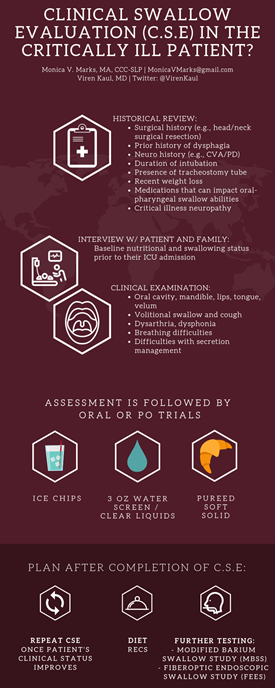What Happens When You Order a Clinical Swallow Examination (CSE)
By: Monica V. Marks, MA, CCC-SLP, and Viren Kaul, MD
June 11, 2019
 When the speech and language pathologist (SLP) is consulted to assess patients in the intensive care unit (ICU), one of the first assessments they will typically complete is a clinical swallow examination (CSE), also referred to as a bedside swallow assessment.
When the speech and language pathologist (SLP) is consulted to assess patients in the intensive care unit (ICU), one of the first assessments they will typically complete is a clinical swallow examination (CSE), also referred to as a bedside swallow assessment.
The CSE is a useful tool for the SLP. Based on their findings, this may warrant additional definitive assessment of swallowings, such as a modified barium swallow study and/or a fiberoptic endoscopic swallow study. The CSE can also be useful to determine if a definitive assessment may be too premature for the ICU patient.
The CSE is the test where you will typically see the SLP team at bedside assessing the patient with various foods and/liquids; however, much more goes into the CSE than just trials of foods of different consistency and liquids.
Prior to the CSE, the SLP will review the medical chart and patient’s history, specifically looking at their readiness for a swallow evaluation (eg, alertness/posture), their current respiratory status, and reason for ICU admission (Macht 2013).
They will review key historical data from the chart, including but not limited to: surgical history that may impact overall swallowing ability and/or airway protection (eg, head/neck surgical resection), history of dysphagia pre-dating their ICU admission, neurological history (eg, CVA/PD), duration of intubation, presence or absence of a tracheostomy tube, recent weight loss, medications that can impact oral-pharyngeal swallow abilities, and/or critical illness neuropathy (Macht 2013).
The SLP will complete a clinical interview with the patient and/or their family member(s) to effectively understand their baseline nutritional and swallowing status prior to their ICU admission. If the patient is able to follow instructions, they will complete an oral, pharyngeal, and laryngeal examination that includes assessment of the oral cavity, mandible, lips, tongue, velum, volitional swallow, and cough. The SLP will note any dysarthria, dysphonia, and/or reduced breath support or difficulties with secretion management. These findings are typically labeled in the SLP note as an oral-peripheral examination or cranial nerve examination.
After gathering all the necessary information, the SLP will then make the determination to proceed with PO trials. Typically, PO trials consist of ice-chips, water with advancement to foods of various textures (eg, pureed, soft solid). SLPs typically start with a standardized screening test, such as the Yale Swallow Screening protocol (Suiter 2014), which requires continuous sips of 3 oz water, with monitoring of any coughing or choking.
On the CSE, the SLP will observe for any overt signs or symptoms of swallowing difficulty including coughing, choking, or changes in vocal quality and watch the bedside monitors for any changes in baseline activity. After completion of the bedside swallow examination, the SLP should be able to confidently establish a plan of care, provide diet recommendations, and/or request for additional instrumental assessment via modified barium swallow study (MBSS) or fiberoptic endoscopic evaluation (FEES) (Murray 1999).
References:
Murray J. (1999). Manual of dysphagia assessment in adults. Cengage Learning. Independence, KY.
Macht M, Wimbish T, Bodine C, Moss M. ICU-acquired swallowing disorders. Crit Care Med. 2013;41(10): 2396-2405. doi: http://dx.doi.org/10.1097/CCM.0b013e31829caf33.
Suiter DM, Sloggy J, Leder SB. Validation of the Yale Swallow Protocol: a prospective double-blinded videofluoroscopic study. Dysphagia. 2014;29.2:199-203.
Authors:
Monica V. Marks, MA, CCC-SLP | MonicaVMarks@gmail.com
Viren Kaul, MD | Twitter: @virenkaul